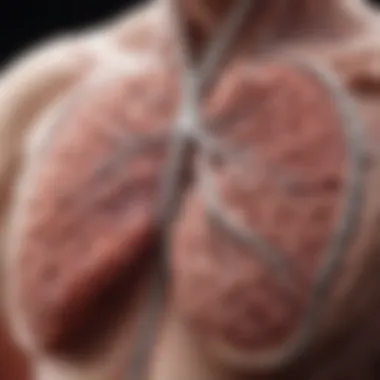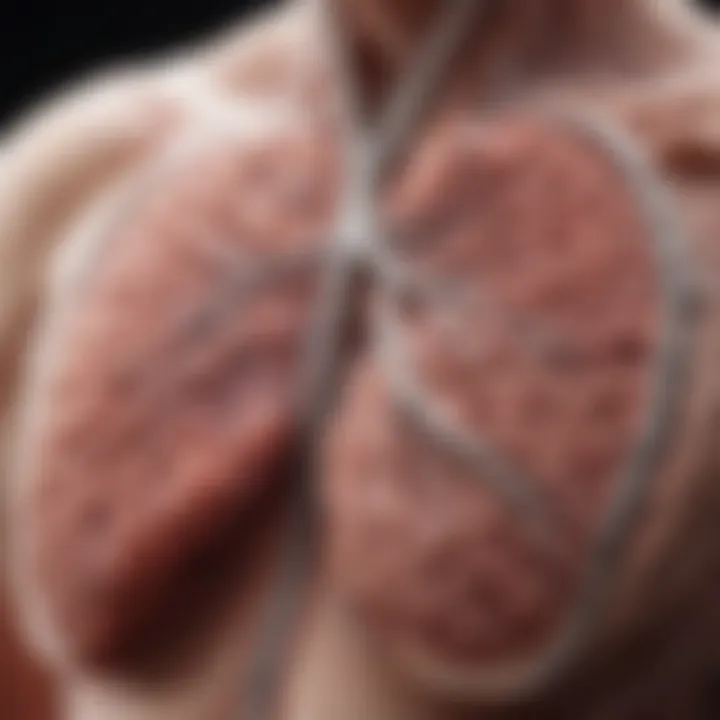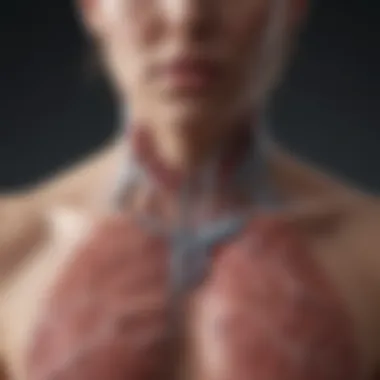Understanding Bronchial Diseases: A Comprehensive Review


Intro
Bronchial diseases encompass a range of conditions that primarily affect the bronchial tubes, which play a crucial role in the respiratory system. Understanding these diseases is essential, not only for healthcare professionals but also for patients and their families. This review aims to examine the underlying mechanisms, diagnostic hurdles, and treatment strategies associated with these disorders. Early detection and effective management of bronchial diseases can significantly improve the quality of life for patients.
Research Overview
Methodological Approaches
The study of bronchial diseases has evolved over the years, with researchers employing various methodological approaches to enhance understanding. Clinical research, cohort studies, and controlled trials are essential in identifying risk factors and gathering data about disease progression. Furthermore, the integration of genetic studies helps elucidate the hereditary aspects of certain bronchial conditions.
Significance and Implications
Investigating bronchial diseases is vital due to their prevalence and impact on health. Conditions such as asthma, chronic bronchitis, and bronchiectasis significantly affect patient wellbeing. Comprehending these diseases can lead to better prevention strategies and improved treatment options. Awareness of the implications of these conditions enables healthcare practitioners to address not only the physical symptoms but also the psychological burdens they impose on patients.
Current Trends in Science
Innovative Techniques and Tools
Recent advancements in research and technology provide new avenues for the study and treatment of bronchial diseases. Techniques such as bronchoscopy allow for direct visualization and possibly targeted interventions. Additionally, the development of advanced imaging techniques provides deeper insights into the structural changes associated with these diseases. These innovations lead to more accurate diagnoses and tailored treatment plans.
Interdisciplinary Connections
Bronchial diseases require collaboration across various medical disciplines. Pulmonologists, allergists, and even psychologists often work together to provide comprehensive care to patients. This interdisciplinary approach ensures that all factors affecting the patient’s health are considered, leading to more effective management strategies.
"A thorough understanding of bronchial diseases is critical in enhancing patient outcomes through informed and proactive healthcare practices."
Preamble to Bronchial Diseases
Bronchial diseases represent a critical area of study within respiratory medicine. These conditions, which affect the bronchi—the large air passages from the trachea to the lungs—can impact a patient's quality of life significantly. Understanding bronchial diseases is essential for early detection and effective management. This article aims to provide a comprehensive overview of various bronchial conditions, emphasizing their relevance and impact.
The importance of acknowledging bronchial diseases lies not only in their prevalence but also in their potential complications. Diseases such as chronic bronchitis, asthma, and bronchiectasis can lead to severe respiratory issues, hospitalizations, and in some cases, can be fatal. Comprehensive knowledge in this area helps healthcare professionals develop better treatment strategies and improve patient outcomes.
Definition and Scope
Bronchial diseases encompass a range of disorders that affect the bronchial tubes. These disorders can be broadly defined as conditions that lead to inflammation, infection, or mechanical obstruction of the bronchi. The scope of bronchial diseases includes both acute conditions and chronic disorders that can persist over time. Chronic bronchitis and asthma are among the most notable chronic diseases, whereas bronchial infections may manifest acutely and with varying severity.
Understanding the depth of bronchial diseases also means recognizing the diverse factors involved, including genetic predispositions, environmental triggers, and lifestyle choices. This multifaceted approach is necessary for effective prevention and treatment.
Epidemiology of Bronchial Diseases
The epidemiology of bronchial diseases reveals significant data about their prevalence and impact on various populations. Studies indicate that conditions like asthma affect millions, with varying statistics based on age, geographical region, and socioeconomic status. Chronic bronchitis is notably prevalent among smokers and those exposed to second-hand smoke. Additionally, bronchiectasis often occurs in individuals with a history of respiratory infections or other lung complications.
Demographic analysis is crucial because it helps delineate which groups are most at risk, thus directing preventative health measures. For instance, public health interventions such as anti-smoking campaigns and educational programs on asthma management could be designed based on the insights gained from epidemiological research.
"Bronchial diseases not only compromise lung function, but they can also lead to significant morbidity and altered quality of life for affected individuals."
Recognition of bronchial diseases and their epidemiology can lead to enhanced public health responses and individual patient education initiatives. Thus, addressing these health concerns is vital for effective practices in healthcare and community well-being.
Bronchial Anatomy and Physiology
Understanding the bronchial anatomy and physiology is essential in the context of bronchial diseases. The bronchial system forms a crucial component of the respiratory tract, facilitating air passage to the lungs. This section will explore the structure and functionality of the bronchi and their role in maintaining respiratory health. Awareness of these elements helps in recognizing how various bronchial diseases arise and progress.
Structure of the Bronchi
The bronchi are tubes that branch off from the trachea and distribute air to each lung. The main bronchus divides into the left and right bronchi, corresponding to each lung. This branching continues into smaller bronchi and ultimately leads to the bronchioles, which are even narrower tubes.
The wall structure of the bronchi consists of several layers:
- Mucosa: This is the innermost layer lined with ciliated epithelial cells and goblet cells that produce mucus. Mucus traps particulates and pathogens, while cilia help move this debris out.
- Cartilage: The bronchi are supported by cartilage rings that prevent collapse. These rings are C-shaped, and smaller bronchi have irregular cartilage plates.
- Smooth Muscle: Surrounding the cartilage, smooth muscle allows for regulation of airway diameter. This muscle can contract or relax to control airflow, playing a critical role during respiratory distress.
This intricate structure enables the bronchi to perform their function effectively while providing flexibility and support as air moves to and from the lungs.
Functionality within the Respiratory System
The bronchi play a significant role in the respiratory system by facilitating airflow to the alveoli, where gas exchange occurs. They act as conductors, ensuring that air reaches the areas necessary for oxygen to enter the bloodstream. Key functions include:
- Air Distribution: The bronchi ensure that inhaled air is evenly distributed throughout the lungs. Proper airflow is essential for adequate gas exchange and overall lung function.
- Defense Mechanism: The structure of the bronchi includes a natural defense system. Mucus traps harmful particles, while cilia help expel them. This mechanism is vital in protecting the body from infections.
- Regulating Airflow: Smooth muscle in the bronchial walls can constrict or dilate, regulating airflow based on the body’s needs. This is particularly important in conditions like asthma, where bronchoconstriction may occur, leading to difficulty in breathing.
"The structure and function of the bronchi are crucial for maintaining normal respiratory mechanics and ensuring adequate oxygen delivery."


Examining bronchial anatomy and physiology sets the foundation for understanding the various types of bronchial diseases explored in subsequent sections. This knowledge is especially relevant for students, researchers, educators, and professionals engaged in respiratory medicine and related fields.
Types of Bronchial Diseases
Understanding the types of bronchial diseases is crucial for proper diagnosis and effective management. Each condition presents unique challenges and requires distinct treatment approaches. The classification of these diseases helps clinicians and researchers focus on specific issues affecting the bronchial system. Moreover, knowing the different types allows patients and caregivers to understand the nature of the disease, improving their engagement in treatment plans.
Chronic Bronchitis
Chronic bronchitis is characterized by a persistent cough and production of sputum for at least three months in two consecutive years. This disease is often a result of long-term exposure to irritants like tobacco smoke or pollution.
The inflammation of the bronchial tubes leads to narrowing and obstruction, making it difficult for air to flow freely. Patients may experience symptoms such as wheezing and difficulty in breathing, particularly during exertion. Chronic bronchitis is often classified as part of Chronic Obstructive Pulmonary Disease (COPD).
Management strategies include:
- Smoking cessation: This is the most effective step to prevent further lung damage.
- Bronchodilators: These medications can help relax the muscles around the airways, improving airflow.
- Corticosteroids: These reduce inflammation in the airways and can help relieve symptoms.
- Pulmonary rehabilitation: A supervised program to enhance lung function and physical endurance.
Bronchiectasis
Bronchiectasis involves the abnormal and permanent dilation of the bronchi, which can result from chronic infections or other underlying conditions. The damage to the airways can create an environment conducive to recurrent infections and inflammation.
Patients commonly report a chronic productive cough, often accompanied by excessive mucus production. The condition can lead to complications such as respiratory failure or severe lung infections. Understanding the underlying causes is essential for management.
Key diagnostic tools include:
- High-resolution computed tomography (HRCT): This imaging technique is critical for assessing the extent of bronchiectasis.
- Sputum culture: Identifying pathogens helps tailor antibiotic therapy.
- Pulmonary function tests: These evaluate the airflow obstruction and help classify the severity of the disease.
Asthma
Asthma is a chronic disease that affects the airways, causing periodic episodes of wheezing, breathlessness, chest tightness, and coughing. It can be triggered by allergens, exercise, cold air, or stress. In asthma, the bronchi become inflamed and hyper-responsive, leading to reversible airflow obstruction.
Common treatments include:
- Inhaled corticosteroids: These decrease inflammation in the airways.
- Long-acting beta-agonists: These are used in conjunction with inhaled corticosteroids for better control of symptoms.
- Leukotriene modifiers: These oral medications can help ease asthma symptoms and reduce the need for reliever medication.
Effective management often involves creating an action plan that includes identifying triggers and regular monitoring of symptoms.
Cystic Fibrosis
Cystic fibrosis is a genetic disorder that affects the respiratory, digestive, and reproductive systems. It is caused by mutations in the CFTR gene, leading to thick, sticky mucus production. This mucus obstructs airways, creating an environment for bacterial infections and respiratory complications.
Patients with cystic fibrosis often experience severe respiratory symptoms, such as chronic cough and lung infections, which can significantly impair quality of life.
Comprehensive treatment approaches often include:
- Airway clearance techniques: Such as chest physiotherapy to help clear mucus.
- Pancreatic enzymes: To aid digestion, as the pancreas may also be affected.
- CFTR modulators: These are newer therapies aiming to correct the underlying defect in the CFTR protein.
Pathophysiology of Bronchial Diseases
Pathophysiology is a critical component in understanding bronchial diseases, as it clarifies the underlying mechanisms that lead to symptom development and disease progression. Knowledge in this area is essential for medical professionals and researchers to identify effective treatments. Inflammation, genetic elements, and environmental factors play prominent roles in the pathophysiology of these diseases. By investigating these aspects, it becomes possible to enhance diagnostic methods and refine therapeutic approaches.
Inflammatory Processes
Inflammation is a hallmark of bronchial diseases. It is characterized by the immune system's response to irritants, pathogens, or damaged tissues. In the case of bronchial diseases, such as chronic bronchitis or asthma, inflammation leads to airway narrowing, increased mucus production, and chronic cough. The immediate physiological processes involve the activation of immune cells like eosinophils and lymphocytes, along with the release of inflammatory mediators such as cytokines.
- Cytokines, like interleukin-4 and interleukin-5, can exacerbate the inflammatory response.
- Mediators, such as histamines, contribute to bronchoconstriction and mucus hypersecretion.
These processes result in a vicious cycle that worsens the disease over time. Understanding these inflammatory pathways is essential for developing targeted therapies that reduce inflammation, alleviate symptoms, and improve patient outcomes.
Role of Genetic Factors
Genetic predisposition plays a significant role in the susceptibility to bronchial diseases. Many patients exhibit variations in genetic markers that can influence the severity and course of these diseases. For instance, individuals with family histories of asthma often carry variants in genes responsible for immune regulation.
Research indicates several genetic factors, including:
- Variations in ADRB2 gene which encodes for adrenergic receptors influencing bronchial dilation.
- Polymorphisms in IL4 and IL13 that predispose individuals to allergic responses and asthma.
These genetic elements often interact with environmental triggers to manifest as pathology, illustrating the complexity of bronchial diseases. Research into these genetic links may reveal novel therapeutic targets and preventive interventions.
Environmental Triggers


Environmental factors are also critical in the pathophysiology of bronchial diseases, serving both as initiators and exacerbators of symptoms. Certain environmental exposures can lead to inflammation and structural changes in the bronchi. Common environmental triggers include:
- Air pollution, particularly particulate matter.
- Tobacco smoke, a well-known exacerbator of chronic bronchitis.
- Allergens, like pollen or mold, that provoke immune responses.
"Environmental insults can significantly impact the bronchial health of individuals, particularly in those with a genetic predisposition."
Additionally, occupational exposures, such as chemical irritants, can increase the risk of developing chronic bronchial conditions. Understanding these triggers not only helps in managing existing diseases but also emphasizes the importance of preventive measures in at-risk populations.
Diagnosis of Bronchial Diseases
Effective diagnosis of bronchial diseases is crucial for appropriate treatment and management. Accurate identification of the specific condition enables healthcare providers to tailor interventions, which can significantly improve patient outcomes. Given the complex nature of bronchial diseases, a multifaceted approach is necessary for diagnosis. This section will explore the key components of clinical assessment, imaging techniques, and pulmonary function tests in diagnosing bronchial diseases.
Clinical Assessment
A thorough clinical assessment is the first step in diagnosing bronchial diseases. It typically begins with a detailed patient history, where practitioners discuss symptoms such as coughing, wheezing, and shortness of breath. Understanding the duration and severity of these symptoms can provide key insights into the underlying condition. Here are important factors to consider during clinical assessments:
- Medical History: Previous lung diseases, and any history of smoking or occupational exposures should be recorded.
- Family History: A genetic predisposition to conditions like asthma or cystic fibrosis can be helpful in diagnosis.
- Physical Examination: Healthcare professionals utilize tools such as stethoscopes to listen for abnormal lung sounds, which might indicate the presence of bronchial diseases.
The clinical assessment is not just about identifying symptoms. It is about building a complete picture of the patient's health, which aids in narrowing down the possibilities before proceeding to more advanced diagnostic techniques.
Imaging Techniques
Imaging plays a significant role in diagnosing bronchial diseases. Standard procedures include chest X-rays and computed tomography (CT) scans, which offer detailed views of the lung structure. These techniques can reveal abnormalities such as:
- Infiltrates: Indicating inflammation or infection within the bronchi.
- Structural Changes: Such as bronchial thickening, which is prevalent in chronic bronchitis.
- Mucous Plugging: Often seen in asthma or cystic fibrosis patients.
Each imaging modality has its advantages. Chest X-rays are usually the first line due to their accessibility and quick results. However, a CT scan provides a more comprehensive view for more complex cases.
Pulmonary Function Tests
Pulmonary function tests (PFTs) are essential for evaluating lung function and determining the severity of bronchial diseases. These tests help quantify airflow obstruction, a common feature in various bronchial conditions. Key components of pulmonary function tests include:
- Spirometry: Measures how much air a patient can exhale and the speed of exhalation. It helps diagnose conditions such as asthma and chronic obstructive pulmonary disease (COPD).
- Lung Volume Testing: Determines the total volume of air the lungs can hold and assesses how effectively the lungs expand.
- Diffusion Capacity: Evaluates how well oxygen passes from the lungs to the bloodstream. It helps identify issues related to the alveoli and is crucial in diagnosing conditions like pulmonary fibrosis.
Diagnosing bronchial diseases involves a comprehensive integration of clinical assessments, imaging techniques, and pulmonary function tests. Each component provides critical information that, when combined, leads to more accurate diagnoses and successful treatment strategies.
Treatment Strategies
Treatment strategies for bronchial diseases encompass a wide range of approaches, which are essential for managing the symptoms and overall condition of patients. Effective treatment can significantly improve the quality of life for individuals suffering from these diseases. Understanding these strategies helps healthcare professionals choose the most suitable methods tailored to individual patient needs, ultimately enhancing patient care.
Pharmacological Approaches
Pharmacological treatments play a crucial role in managing bronchial diseases. These approaches involve the use of medications to alleviate symptoms, reduce inflammation, and improve lung function. Common classes of medications include corticosteroids, bronchodilators, and antibiotics.
- Corticosteroids are used primarily to reduce inflammation in the airways. They can be administered orally or inhaled, depending on the severity of the condition.
- Bronchodilators help open up the bronchial passages, making it easier for patients to breathe. Short-acting bronchodilators provide quick relief, while long-acting ones are effective for daily use.
- Antibiotics may be prescribed when infections complicate bronchial diseases, especially in chronic conditions like bronchiectasis or chronic bronchitis.
Considering the appropriate pharmacological approach is vital to address individual patients' conditions while minimizing adverse effects. Dosages and timing should be monitored carefully by healthcare professionals.
Non-Pharmacological Interventions
Non-pharmacological interventions complement medication and are vital in the holistic treatment of bronchial diseases. These strategies focus on improving patients' respiratory health through lifestyle changes and supportive therapies.
- Pulmonary Rehabilitation is a structured program that combines exercise training, education, and support. It aims to improve the physical and emotional well-being of patients.
- Smoking Cessation Programs are critical for individuals with lung diseases caused or exacerbated by smoking. Reducing or eliminating exposure to tobacco significantly improves lung function and overall health.
- Nutritional Support helps in managing chronic diseases by ensuring that patients receive proper nutrients, enhancing their immune function and energy levels.
These interventions highlight the importance of patient education and self-management strategies. Encouraging healthful behavior can lead to better disease outcomes and quality of life.
Surgical Options
In some severe cases of bronchial diseases, surgical intervention may be necessary. Surgical options are typically considered when other treatments have failed or when there is significant damage to the bronchial structures.
- Lung Volume Reduction Surgery (LVRS) may benefit patients with severe emphysema. This procedure removes damaged lung tissue, allowing the remaining healthy parts to function more efficiently.
- Bronchial Tube Reconstruction is performed when structural anomalies or chronic infections lead to severe bronchial damage.
- Lung Transplantation is an option for end-stage lung diseases. It offers a chance for restoration of normal lung function in selected patients, but it comes with risks and challenges associated with post-operative care.
It is critical to assess each patient's overall health, specific disease characteristics, and surgical risks before considering a surgical option. An interdisciplinary team approach is recommended for optimal patient outcomes.
"A comprehensive treatment plan addressing both pharmacological and non-pharmacological elements is vital for managing bronchial diseases effectively."
By understanding and implementing these treatment strategies, healthcare providers can help optimize care for patients with bronchial diseases. Ongoing research and advancements in medicine continue to improve these strategies, enhancing prospects for better patient outcomes in the future.
Recent Advancements in Bronchial Disease Research


Research into bronchial diseases is evolving rapidly, yielding promising insights and therapies. This section provides an in-depth understanding of the latest advancements in the field, emphasizing the role of biomarkers and novel therapeutics. These developments may lead to improved diagnostic and treatment strategies, ultimately enhancing patient care and outcomes.
Biomarkers for Bronchial Diseases
Biomarkers are crucial for identifying and managing bronchial diseases. They facilitate early detection, help track disease progression, and measure responses to therapy. In recent years, researchers have focused on discovering specific biomarkers associated with conditions like asthma, chronic bronchitis, and bronchiectasis.
Some noteworthy findings include:
- Exhaled breath condensate: Studies have shown that components in exhaled breath can indicate airway inflammation. This can help differentiate between various bronchial diseases.
- Blood-based biomarkers: Certain cytokines and proteins in blood samples correlate with disease severity. These can be valuable for monitoring treatment efficacy.
- Genetic markers: Advances in genomics have identified specific genetic variations linked to bronchial diseases. Understanding these can lead to personalized treatment options for patients.
Overall, integrating biomarkers in clinical settings enhances precision in diagnosing bronchial diseases and tailoring treatments to individual needs. This is a significant step forward in respiratory medicine.
Novel Therapeutics Under Investigation
The development of novel therapeutics represents a significant advance in managing bronchial diseases. Research efforts are focused on innovative drugs that can target specific mechanisms of disease. Some promising lines of inquiry include:
- Biologics: These are targeted therapies that address underlying inflammatory processes in diseases like asthma. Recent studies suggest that biologics can reduce exacerbations and improve quality of life for patients.
- Small molecule inhibitors: Research is ongoing into small molecules that interfere with specific pathological pathways, offering alternatives to traditional treatments. For instance, inhibitors targeting the phosphodiesterase pathway have shown promise in preclinical studies.
- Gene therapy: While still largely experimental, gene therapy holds potential for treating inherited forms of bronchial diseases, such as cystic fibrosis. Early trials show promising results in correcting the defective genes responsible for these conditions.
"Innovative therapies aim to redefine the future management of bronchial diseases, highlighting the shift towards a more personalized approach to treatment."
Impact of Bronchial Diseases on Quality of Life
The impact of bronchial diseases on quality of life is a significant concern for both patients and healthcare providers. Chronic conditions such as asthma, chronic bronchitis, and bronchiectasis can greatly hinder daily activities. These diseases often lead to physical limitations and psychosocial consequences that can reshape a person's lifestyle. Understanding these effects is essential for developing comprehensive treatment plans, ensuring that both medical and emotional health are addressed.
Physical Limitations
Bronchial diseases lead to varying degrees of physical limitations. Patients often experience symptoms like shortness of breath, chronic coughing, and fatigue, which can impede their ability to engage in routine activities. Simple tasks, such as climbing stairs or walking to the store, become challenging. This inability to perform daily tasks can diminish physical fitness and affect overall health.
- Respiratory Symptoms: Patients may struggle even with minimal exertion.
- Reduced Exercise Tolerance: The inability to exercise not only affects physical health but also reduces motivation.
- Dependency on Medication: Continuous reliance on inhalers and nebulizers can also affect a person's freedom to engage in activities.
Importantly, the limitations in physical activity can lead to a sedentary lifestyle. This scenario creates a cycle where reduced activity worsens lung function, leading to further decline in health and quality of life.
Psychosocial Consequences
Psychosocial aspects of living with bronchial diseases are crucial yet often overlooked in traditional medical settings. The daily struggles with symptoms can lead to chronic stress, anxiety, and depression. Patients may find themselves feeling isolated or misunderstood by those who do not share similar experiences.
- Mental Health Issues: Many experience anxiety about their condition, which can lead to avoidance of social activities.
- Social Isolation: The fear of an asthma attack or a coughing fit can create barriers to interacting with others, leading to feelings of loneliness.
- Impact on Relationships: Bronchial diseases can strain familial and social relationships. Family members might not fully understand the challenges the patient faces, leading to frustration on both sides.
"Recognizing the psychosocial consequences of bronchial diseases is essential for holistic patient care. It allows for better integration of psychological support into treatment plans."
Addressing both physical and mental health aspects of bronchial diseases is vital. Patients who receive support in these areas often report better overall health and satisfaction with their lives. In summary, bronchial diseases create a multifaceted impact on the quality of life, ranging from physical limitations to significant psychosocial consequences. Understanding these aspects is key to providing effective care.
Preventive Measures for Bronchial Diseases
Preventive measures play a pivotal role in managing bronchial diseases. These diseases often have complex origins and can significantly impair an individual's quality of life. Therefore, focusing on prevention can not only help reduce the incidence of these conditions but also improve overall health outcomes. By implementing effective preventive strategies, patients can mitigate risks and enhance their well-being. In this section, we will delve into lifestyle modifications and vaccination and infection control as key preventive measures.
Lifestyle Modifications
Making specific lifestyle changes can greatly reduce the risk of developing bronchial diseases. Here are some effective modifications:
- Avoiding tobacco smoke: Smoking is a major risk factor for many bronchial diseases, particularly chronic bronchitis and asthma. Quitting smoking improves lung function and decreases symptom severity.
- Maintaining a healthy diet: A balanced diet rich in fruits, vegetables, and whole grains can bolster the immune system. Nutritional choices may also play a part in inflammation reduction, benefiting those with bronchial conditions.
- Regular exercise: Physical activity strengthens respiratory muscles and enhances lung capacity. It can also help maintain a healthy body weight, which is crucial since obesity can exacerbate bronchial diseases.
- Environmental modifications: Reducing exposure to allergens and pollutants is essential. This includes using air purifiers, managing indoor humidity, and avoiding known allergens in the atmosphere.
- Stress management: High-stress levels can trigger or worsen symptoms of bronchial diseases such as asthma. Techniques like mindfulness, yoga, and other relaxation practices can help regulate stress responses.
Making conscious lifestyle changes can form a strong foundation for preventing many bronchial diseases, benefiting respiratory health overall.
Vaccination and Infection Control
Vaccination is another critical preventive measure against bronchial diseases. Infectious agents can exacerbate or even lead to various chronic conditions. Key vaccinations include:
- Influenza vaccine: The flu can lead to severe respiratory complications in individuals with existing bronchial conditions. Annual vaccination can reduce this risk.
- Pneumococcal vaccine: This vaccine protects against pneumonia, a common complication for those with chronic bronchial diseases. It is especially recommended for the elderly and immunocompromised individuals.
Effective infection control practices should also be emphasized. This includes:
- Hand hygiene: Regular handwashing can reduce infections significantly, lowering the risk of exacerbating bronchial diseases after exposure.
- Avoiding close contact with sick individuals: Staying away from those who are ill can prevent transmission of respiratory infections.
- Creating a healthy living environment: Ensuring good ventilation in homes and workplaces helps decrease airborne pathogens, contributing to reduced respiratory complications.
The End
The conclusion serves as an integral part of this article, consolidating the critical insights gained throughout our examination of bronchial diseases. In this final section, we reaffirm the significance of understanding bronchial diseases, particularly through the lens of their impact on patient management and care.
Summary of Key Findings
Throughout the article, a variety of bronchial diseases were dissected, showcasing the complex interplay of genetic, environmental, and physiological factors involved in these conditions.
- Pathophysiology: We explored the inflammatory processes and the role of genetic predispositions, emphasizing that bronchial diseases are often multifactorial in nature.
- Diagnosis: Clinical assessments, imaging techniques, and pulmonary function tests were highlighted as essential tools for accurate diagnosis. The importance of early diagnosis cannot be overstated, as it leads to better management and outcomes.
- Treatment: Various treatment strategies such as pharmacological approaches, non-pharmacological interventions, and surgical options were discussed, illustrating the diverse needs of patients.
- Quality of Life: The discussion on the psychosocial impact of bronchial diseases revealed how these conditions extend beyond physical limitations, influencing overall well-being and life satisfaction.
Understanding these dimensions equips healthcare providers, researchers, and patients with the knowledge necessary for informed decision-making and impactful interventions.
Future Directions in Research
Looking ahead, there are several promising avenues for future research in the field of bronchial diseases:
- Biomarker Development: Identifying specific biomarkers for early detection and personalized treatment plans can enhance the understanding of disease pathways and improve therapeutic outcomes.
- Novel Therapeutics: Ongoing investigations into new drugs and treatment modalities hold the potential for transformative approaches to managing bronchial diseases.
- Longitudinal Studies: More extensive studies tracking patients over time may provide deeper insights into the progression of these diseases and the long-term effectiveness of various treatment strategies.
- Interdisciplinary Research: Collaborations between different fields, such as genetics, environmental science, and inhalation therapy, could yield more holistic approaches to tackling bronchial diseases.



